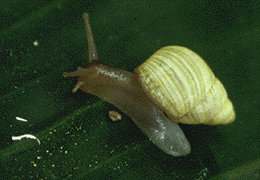Partulidae
| Partulidae | ||||||||||||
|---|---|---|---|---|---|---|---|---|---|---|---|---|

|
||||||||||||
| Systematics | ||||||||||||
|
||||||||||||
| Scientific name | ||||||||||||
| Partulidae | ||||||||||||
| Pilsbry , 1900 |
The Partulidae , sometimes also called tree snails, are a family of snails from the suborder of the land snails (Stylommatophora). Many species of the family are or were endemic to individual islands in the Pacific Ocean. A total of at least 140 species are known. Many are endangered or already extinct.
features
The cases are medium to large, low to highly conical, oval to slim. It can be right or left wound. The mouth edges are widened and turned back. There are no lamellae or plicae, but the parietal wall often has a short tooth. The surfaces are smooth or spirally striped or ribbed. The sole is not divided into fields. In the hermaphroditic genital system, the penis is usually simple, without an epiphallus, but a flagellum may be present. The penile retractor is attached to the penis apically or subapically. The spermatic duct arises just below the albumin gland, the prostate is generally small and rounded. The stem of the spermathec is relatively long, the reservoir itself of different shapes.
Like all lung snails, the Partulidae are hermaphrodites . As their Latin name suggests, they give birth to their offspring alive ( viviparia ).
Occurrence, way of life and distribution
The distribution of the family is limited to the Pacific region. The species are mostly tree dwellers.
Danger
Most types of partulidae family, according to the Red List of IUCN now extinct, the remaining highly endangered. As K-strategists, these tree snails give birth to only a few - in some species only about 20 - offspring in the course of their life, adapting to the low threat from predators, such as existed before the arrival of humans. The main causes of the hazard are therefore in addition to the destruction of forests and. a. by goats the introduction of competing herbivorous, especially predatory animal species, which have established themselves as invasive species on the Pacific islands. The great agate snail ( Achatina fulica ) successfully displaced native snail species through food competition . To combat the agate snails, predatory snail species, including the rosy wolf snail ( Euglandina rosea ), were released on many islands , but in particular they ate easily captured native, viviparous snails, whereupon their populations collapsed. Another factor in the destruction of tree snails is the land planarie Platydemus manokwari , which was also introduced from New Guinea to fight agate snails .
In 1987 the Zoological Society of London initiated a conservation breeding program for the remaining Partula species, in which surviving specimens of snails were brought to London Zoo . With regard to Partula turgida , the program failed. In 1993 they succeeded in increasing their population in the London Zoo to 400 individuals, most of which were released into a fenced reserve on the island of Moorea in 1994 . In 1995, rosy wolf slugs were able to enter the reserve and killed all of the Partula slugs. The specimens that remained in the London Zoo gradually died as a result of an infectious disease caused by the Steinhausia parasite .
Systematics
The family of the Partulidae is the nominotypical family of the superfamily Partuloidea Pilsbry, 1900, which in addition to the Partulidae also contains the monotypical family Draparnaudiidae .
- Partulidae Pilsbry, 1900
- Genus Eua Pilsbry & Cooke, 1934 (with the subgenus Eua Pilsbry & Cooke, 1934, Neanassa Pilsbry & Cooke, 1934 and Thakombaua Pilsbry, 1909)
- Genus Partula Férussac, 1819 (with the subgenus Partula Férussac, 1819, Melanesica Pilsbry, 1909, Carolinella Pilsbry, 1909, Marianella Pilsbry, 1909, Leptopartula Pilsbry, 1909 and Palaopartula Pilsbry, 1909)
- Genus Rennellia Clench, 1941
- Genus Samoana Pilsbry, 1909 (with the subgenus Samoana Pilsbry, 1909 and Marquesana Pilsbry, 1909)
- Genus Sphendone Slapcinsky & Kraus, 2016
Phylogeny
According to the molecular genetic analysis by Wade et al. (2006) the partulidae form the sister group of a larger group of worm families, all the Orthurethra include -type (Cochlicopidae, Valloniidae, Vertiginidae, Orculidae u. A.). However, the analysis is still based on a few taxa. Remarkably, the genus Draparnaudia in this diagram is not the sister group of the Partulidae, but is closely related to the Gastrocoptinae . This naturally raises questions about the correct position of the Draparnaudiidae in the Partuloidea.
swell
Individual evidence
- ↑ Search for “Partulidae” in the IUCN Red List of Threatened Species . Retrieved November 10, 2009.
- ^ IUCN (2013). IUCN Red List of Threatened Species . Version 2013.2
- ^ Platydemus manokwari (flatworm): General Impact . Global Invasive Species Database. Retrieved October 12, 2015.
- ↑ Dan Ferber: Bug Vanquishes Species. Science, 218: 215 1998 doi : 10.1126 / science.282.5387.215b
literature
- Philippe Bouchet and Jean-Pierre Rocroi: Part 2. Working classification of the Gastropoda. Malacologia, 47: 239-283, Ann Arbor 2005 ISSN 0076-2997
- Antolij A. Schileyko: Treatise on Recent Terrestrial Pulmonate Molluscs Part 3 Partulidae, Aillyidae, Bulimulidae, Orthalicidae, Megaspiridae, Urocoptidae. Ruthenica, Supplement 2 (3): 261-436, Moscow 1999 ISSN 0136-0027
- Christopher M. Wade, Peter B. Mordan, and Fred Naggs: Evolutionary relationships among the Pulmonate land snails and slugs (Pulmonata, Stylommatophora). Biological Journal of the Linnean Society, 87: 593-610, Oxford 2006 ISSN 0024-4066 doi : 10.1111 / j.1095-8312.2006.00596.x